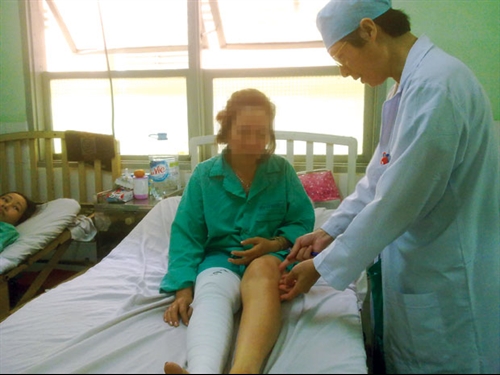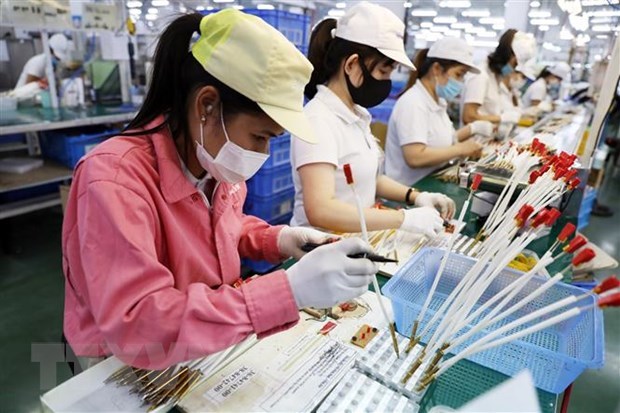 Society
Society

The proportion of patients with chronic venous insufficiency (CVI) is increasing steadily as the population ages rapidly, but most of them do not receive timely treatment, experts say.
 |
| A doctor treating a patient with chronic venous insufficiency at the 115 People (Nhan Dan) Hospital. — Photo sgtt.com.vn |
Gia Lộc
HCM CITY — The proportion of patients with chronic venous insufficiency (CVI) is increasing steadily as the population ages rapidly, but most of them do not receive timely treatment, experts say.
The problem has not received enough attention because of low awareness, they said at a counselling workshop last Saturday.
Dr Nguyễn Văn Việt Thành, vice chairman of HCM City Phlebology Society, said many CVI patients admitted to the city’s Bình Dân Hospital, where the workshop was held, were in serious condition.
Many patients do not get early treatment because CVI symptoms are similar to that of problems with bones, joints and peripheral nerves, he said.
And 75 per cent of people with these symptoms do not get timely treatment, said Trần Công Quyền, head of the Bình Dân Hospital’s vascular, thorax and goitre ward.
Thành said anyone who gets swelling or cramp in legs, should visit a hospital for proper diagnosis. They should not wait for varicose veins on the surface because not all patients with CVI have the same symptoms.
In fact, periodical health examinations should be encouraged for early detection of such problems, he said.
At the workshop, an 84-year-old man from District 3 said he had been noticing varicose veins on the surface over the last year. He said he can feel swelling in his legs after sitting for about two hours.
“Do I have CVI? How can I treat it,” he asked.
Quyền confirmed that the octogenarian did have CVI and should avoid sitting for long periods. The doctor also said the senior citizen should visit the hospital for more examinations and proper treatment.
Keep moving
Professor Trần Công Minh of the hospital said patients with CVI should walk, ride bicycles or swim regularly.
“When we are children, we should encourage movement in order to prevent several conditions including CVI. Once CVI has been diagnosed, patients should not stop their movements. Proper diet and exercise will help us stay healthy,” Minh said.
Many patients have misunderstood that having CVI means all exercise should be stopped, he said.
Quyền said medicines will help reduce symptoms like swellings, heaviness, fatigue or restless legs, as well as discoloring of the skin.
Eating various kinds of fresh fruits, especially those containing kalium, should be encouraged, he said.
It is not right that patients with CVI steep their foot in warm water, he said, explaining that this would make the veins stretch.
Doctors at the workshop said that elastic compression stockings are prescribed to squeeze the leg veins and exert additional pressure that helps prevent blood from flowing backwards.
“Such stockings are used for treatment,” Thành of the HCM City Phlebology Society said, adding: “It is best that patients buy this at the hospital pharmacies.”
It is dangerous that elastic compression stockings are sold without doctors’ prescription at drug stores, because many pharmacists do not have professional knowledge about such things, he said.
If patients wear the stockings that are not of the proper size and elastic compression, the treatment will not be effective, and they may experience discomfort.
Patients with CVI who also have heart diseases should not wear the stockings because of the risk of heart failure, he added.
‘Old’ disease
Thành said that the incidence of CVI rises with age. As the population ages, so does the proportion of people with CVI increase. But, as of now, there are no official figures on the proportion of people with CVI in Việt Nam, he added.
He noted that in western countries, the condition is said to have a severe socio-economic impact because of the high costs of treating it. Hence, Việt Nam has to pay serious attention to the problem.
A research carried at the Bình Dân Hospital around 10 years ago showed that the rate of patients with the disease was 40.5 per cent in the 40-50 age group.
“The rate shows that the CVI is common in the country. Its risk factors include age and people who stand or sit for a long time – more than two hours – when working,” he said.
At the Bình Dân Hospital, several people receiving treatment are young at 20 and above, showing that the problem was appearing among the young population as well, he added.
Pregnant women or those who wear high-heeled shoes frequently are also in the high risk group.
While the condition is rarely fatal, it can reduce the quality of life.
Thành said doctors in hospitals across the country have the capacity to diagnose and treat CVI.
Patients should visit hospitals in their localities for treatment because this is a chronic condition requiring prolonged treatment, he said.
Thành also said that receiving treatment in local hospitals will help patients through ease of access and gaining full health insurance benefits.
In case the condition gets serious, patients can be taken to hospitals where wards specializing in vascular problems can use advanced technology including laser treatment and surgery.
Striking an optimistic note, Thành said that family doctor clinics being set up throughout the city can help improve the quality of primary healthcare and provide effective screening and surveillance of CVI and other diseases. — VNS









